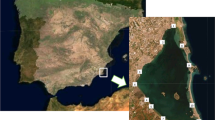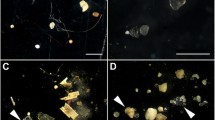Abstract
Phthalates, isopropylpalmitate and synthetic musks were studied in water samples from the Lippe and Rhine rivers, Germany, using compound-specific stable carbon isotope analysis. It is shown that various compounds are characterised by systematic trends of isotopic signatures. Significant shifts of isotopic ratios of the plasticiser DEHP in Rhine river samples, ranging from Δδ13C=1.9 to Δδ13C=3.2 have been correlated with contributions derived from discharging tributaries. Isotopic patterns of the synthetic musk HHCB correlated with the compounds’ load quantities. Such correlations are the first steps for a descriptive characterisation of isotopic fractionation processes in aquatic systems, which can provide a better understanding of the fate of organic xenobiotics in rivers.


Similar content being viewed by others
References
Dsikowitzky L, Schwarzbauer J, Littke R (2002) Distribution of polycyclic musks in water and particulate matter of the Lippe River (Germany). Org Geochem 33:1747–1758
Dsikowitzky L, Schwarzbauer J, Littke R (2004) The anthropogenic contribution to the organic load of the Lippe River (Germany). Part II: Quantification of specific organic contaminants. Chemosphere 57:1275–1288
Hammer BT, Kelley CA, Coffin RB, Cifuentes LA, Mueller JG (1998) δ13C values of polycyclic aromatic hydrocarbons collected from two creosote-contaminated sites. Chem Geol 152:43–58
Heberer T, Gramer S, Stan HJ (1999) Occurrence and distribution of organic contaminants in the aquatic system in Berlin. Part III: Determination of synthetic musks in Berlin surface water applying solid-phase microextraction (SPME) and gas chromatography–mass spectrometry (GC–MS). Acta Hydrochim Hydrobiol 27:150–156
Ishiwatari R, Uzaki M, Yamada K (1994) Carbon isotope composition of individual n-alkanes in recent sediments. Org Geochem 21:801–808
Kronimus A, Schwarzbauer J, Dsikowitzky L, Heim S, Littke R (2004) Anthropogenic organic contaminants in sediments of the Lippe river, Germany. Water Res 38:3473–3484
Lichtfouse E (2000) Compound specific isotope analysis. Application to archaelogy, biomedical sciences, biosynthesis, environment, extraterrestrial chemistry, food science, humic substances, microbiology, organic geochemistry, soil science and sport. Rapid Commun Mass Spectrom 14:1337–1344
Lollar BS, Slater GF, Sleep B, Witt M, Klecka GM, Harkness M, Spivack J (2001) Stable carbon evidence for intrinsic bioremediation of tetrachloroethene at Area 6, Dover Air Force Base. Environ Sci Technol 35:261–269
Sano M, Yotsui Y, Abe H, Sasaki S (1976) A new technique for the detection of metabolites labelled by the isotope13C using mass fragmentography. Biomed Mass Spectrom 3:1–3
Schwarzbauer J, Dsikowitzky L, Heim S, Littke R (2005) Determination of 13C/12C-ratios of anthropogenic organic contaminants in river water samples by GC–irmMS. J Environ Anal Chem 85:349–364
Author information
Authors and Affiliations
Corresponding author
Rights and permissions
About this article
Cite this article
Kronimus, A., Schwarzbauer, J., Dsikowitzky, L. et al. Compound-specific stable carbon isotope analyses of riverine water organic contaminants. Environ Chem Lett 4, 23–28 (2006). https://doi.org/10.1007/s10311-005-0021-2
Received:
Accepted:
Published:
Issue Date:
DOI: https://doi.org/10.1007/s10311-005-0021-2




